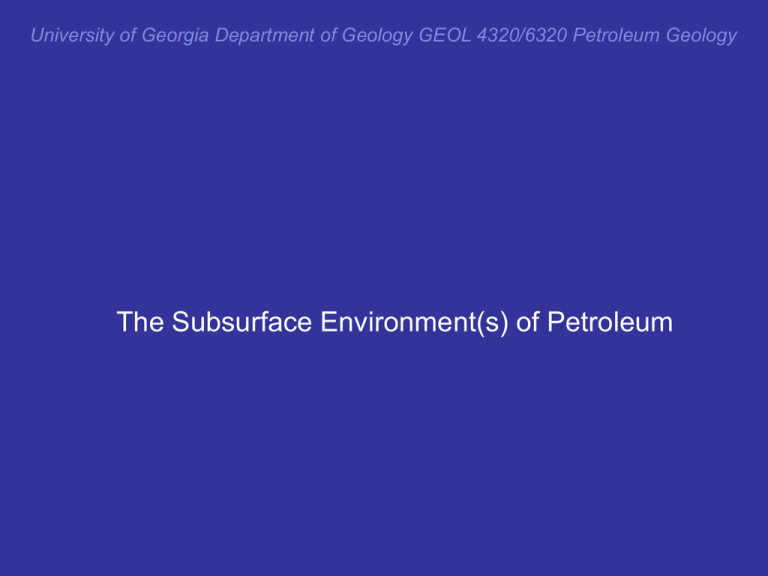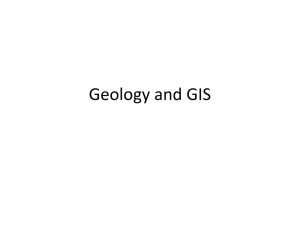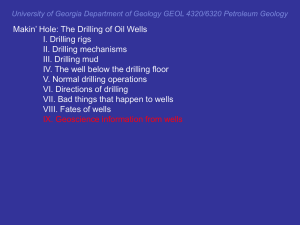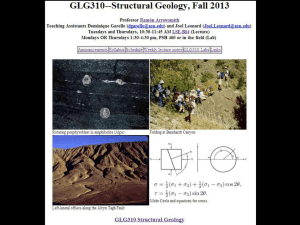4320Lxr02v02SubsurfaceEnvts
advertisement

University of Georgia Department of Geology GEOL 4320/6320 Petroleum Geology The Subsurface Environment(s) of Petroleum University of Georgia Department of Geology GEOL 4320/6320 Petroleum Geology The Subsurface Environment(s) of Petroleum I. Depth II. Temperature III. Water Chemistry IV. Pressure University of Georgia Department of Geology GEOL 4320/6320 Petroleum Geology The Subsurface Environment(s) of Petroleum I. Depth Typical depths: 1,000 - 10,000 feet / 300-3000 meters Deepest petroleum well to date: BP’s 2009 Tiber discovery well in Gulf of Mexico 35,055 ft / 10,685 m sub-seafloor in 4132 ft / 1259 m of water in Lower Tertiary strata Drilled by the Deepwater Horizon rig destroyed in April 2010. Deepest (?) onshore petroleum well GHK #1-27 Bertha Rogers in Washita County, Oklahoma (Anadarko Basin) (1974) 31,441 feet / 9583 m, P&A in molten sulfur Deepest drillhole to date: Kola Superdeep Borehole in Kola Peninsula, Russia (1989) 40,230 ft / 12,262 m (drilled non-rotary with a mud-motor bit) Temperature Pressure Water Chemistry University of Georgia Department of Geology GEOL 4320/6320 Petroleum Geology University of Georgia Department of Geology GEOL 4320/6320 Petroleum Geology The Subsurface Environment(s) of Petroleum I. Depth Typical depths: 1,000 - 10,000 feet / 300-3000 meters Deepest petroleum well to date: BP’s 2009 Tiber discovery well in Gulf of Mexico 35,055 ft / 10,685 m sub-seafloor in 4132 ft / 1259 m of water in Lower Tertiary strata Drilled by the Deepwater Horizon rig destroyed in April 2010. Deepest (?) onshore petroleum well GHK #1-27 Bertha Rogers in Washita County, Oklahoma (Anadarko Basin) (1974) 31,441 feet / 9583 m, P&A in molten sulfur Deepest drillhole to date: Kola Superdeep Borehole in Kola Peninsula, Russia (1989) 40,230 ft / 12,262 m (drilled non-rotary with a mud-motor bit) Temperature Pressure Water Chemistry University of Georgia Department of Geology GEOL 4320/6320 Petroleum Geology University of Georgia Department of Geology GEOL 4320/6320 Petroleum Geology University of Georgia Department of Geology GEOL 4320/6320 Petroleum Geology BP’s Tiber discovery well University of Georgia Department of Geology GEOL 4320/6320 Petroleum Geology The Subsurface Environment(s) of Petroleum I. Depth Typical depths: 1,000 - 10,000 feet / 300-3000 meters Deepest petroleum well to date: BP’s 2009 Tiber discovery well in Gulf of Mexico 35,055 ft / 10,685 m sub-seafloor in 4132 ft / 1259 m of water in Lower Tertiary strata Drilled by the Deepwater Horizon rig destroyed in April 2010. Deepest (?) onshore petroleum well GHK #1-27 Bertha Rogers in Washita County, Oklahoma (Anadarko Basin) (1974) 31,441 feet / 9583 m, P&A in molten sulfur Deepest drillhole to date: Kola Superdeep Borehole in Kola Peninsula, Russia (1989) 40,230 ft / 12,262 m (drilled non-rotary with a mud-motor bit) Temperature Pressure Water Chemistry University of Georgia Department of Geology GEOL 4320/6320 Petroleum Geology The Subsurface Environment(s) of Petroleum I. Depth Typical depths: 1,000 - 10,000 feet / 300-3000 meters Deepest petroleum well to date: BP’s 2009 Tiber discovery well in Gulf of Mexico 35,055 ft / 10,685 m sub-seafloor in 4132 ft / 1259 m of water in Lower Tertiary strata Drilled by the Deepwater Horizon rig destroyed in April 2010. Deepest (?) onshore petroleum well GHK #1-27 Bertha Rogers in Washita County, Oklahoma (Anadarko Basin) (1974) 31,441 feet / 9583 m, P&A in molten sulfur. Deepest drillhole to date: Kola Superdeep Borehole in Kola Peninsula, Russia (1989) 40,230 ft / 12,262 m (drilled non-rotary with a mud-motor bit) Temperature Pressure Water Chemistry University of Georgia Department of Geology GEOL 4320/6320 Petroleum Geology The Subsurface Environment(s) of Petroleum I. Depth Typical depths: 1,000 - 10,000 feet / 300-3000 meters Deepest petroleum well to date: BP’s 2009 Tiber discovery well in Gulf of Mexico 35,055 ft / 10,685 m sub-seafloor in 4132 ft / 1259 m of water in Lower Tertiary strata Drilled by the Deepwater Horizon rig destroyed in April 2010. Deepest (?) onshore petroleum well GHK #1-27 Bertha Rogers in Washita County, Oklahoma (Anadarko Basin) (1974) 31,441 feet / 9583 m, P&A in molten sulfur. Deepest drillhole to date: Kola Superdeep Borehole in Kola Peninsula, Russia (1989) 40,230 ft / 12,262 m (drilled non-rotary with a mud-motor bit) Temperature University of Georgia Department of Geology GEOL 4320/6320 Petroleum Geology The Subsurface Environment(s) of Petroleum I. Depth Deepest petroleum well to date: BP’s 2009 Tiber discovery well in Gulf of Mexico 35,055 ft / 10,685 m sub-seafloor Deepest (?) onshore petroleum well GHK #1-27 Bertha Rogers in Washita County, Oklahoma 31,441 feet / 9583 m, P&A in molten sulfur. Deepest drillhole to date: Kola Superdeep Borehole in Kola Peninsula, Russia (1989) 40,230 ft / 12,262 m (drilled non-rotary with a mud-motor bit: With a lot of rounding: Deepest onshore petroleum well: 30 thousand feet Deepest offshore petroleum well: 35 thousand feet Deepest well/borehole of any sort: 40 thousand feet University of Georgia Department of Geology GEOL 4320/6320 Petroleum Geology The Subsurface Environment(s) of Petroleum I. Depth II. Temperature Relevant range: 60-250°C Geothermal gradients: 5-100 °C/km Typically ~25 °C/km Bottom-hole Temperatures (BHTs) Significance: (past) Thermal maturation of kerogen to yield petroleum Oil window: ~65-160°C Decreased resistivity of formation waters Degradation / melting of drill bit Pressure Water Chemistry University of Georgia Department of Geology GEOL 4320/6320 Petroleum Geology The Subsurface Environment(s) of Petroleum I. Depth II. Temperature Relevant range: 60-250°C Geothermal gradients: 5-100 °C/km Typically ~25 °C/km (Lowest T of oil generation to ~metamorphism) Bottom-hole Temperatures (BHTs) Significance: (past) Thermal maturation of kerogen to yield petroleum Oil window: ~65-160°C Decreased resistivity of formation waters Degradation / melting of drill bit Pressure Water Chemistry University of Georgia Department of Geology GEOL 4320/6320 Petroleum Geology The Subsurface Environment(s) of Petroleum I. Depth II. Temperature Relevant range: 60-250°C Geothermal gradients: 5-100 °C/km Typically ~25 °C/km Bottom-hole Temperatures (BHTs) Significance: (past) Thermal maturation of kerogen to yield petroleum Oil window: ~65-160°C Decreased resistivity of formation waters Degradation / melting of drill bit Pressure Water Chemistry University of Georgia Department of Geology GEOL 4320/6320 Petroleum Geology Geothermal gradients: From smu.edu/geothermal/heatflow/heatflow.htm University of Georgia Department of Geology GEOL 4320/6320 Petroleum Geology Geothermal gradients: Both are from smu.edu/geothermal/heatflow/heatflow.htm Heatflow (at right) = conductivity x gradient (at left) University of Georgia Department of Geology GEOL 4320/6320 Petroleum Geology University of Georgia Department of Geology GEOL 4320/6320 Petroleum Geology University of Georgia Department of Geology GEOL 4320/6320 Petroleum Geology Geothermal gradients: Alsharhan & Nairn 1997 University of Georgia Department of Geology GEOL 4320/6320 Petroleum Geology Geothermal gradients: Alsharhan & Nairn 1997 University of Georgia Department of Geology GEOL 4320/6320 Petroleum Geology The Subsurface Environment(s) of Petroleum I. Depth II. Temperature Relevant range: 60-250°C Geothermal gradients: 5-100 °C/km Typically ~25 °C/km Bottom-hole Temperatures (BHTs) Measured during logging, well after circulation has stopped. Significance: (past) Thermal maturation of kerogen to yield petroleum Oil window: ~65-160°C Decreased resistivity of formation waters Degradation / melting of drill bit Pressure Water Chemistry University of Georgia Department of Geology GEOL 4320/6320 Petroleum Geology The Subsurface Environment(s) of Petroleum I. Depth II. Temperature Relevant range: 60-250°C Geothermal gradients: 5-100 °C/km Typically ~25 °C/km Bottom-hole Temperatures (BHTs) Measured during logging, well after circulation has stopped. Significance: (past) Thermal maturation of kerogen to yield petroleum Oil window: ~65-160°C Decreased resistivity of formation waters Degradation / melting of drill bit Pressure Water Chemistry University of Georgia Department of Geology GEOL 4320/6320 Petroleum Geology University of Georgia Department of Geology GEOL 4320/6320 Petroleum Geology University of Georgia Department of Geology GEOL 4320/6320 Petroleum Geology The Subsurface Environment(s) of Petroleum I. Depth II. Temperature Relevant range: 60-250°C Geothermal gradients: 5-100 °C/km Typically ~25 °C/km Bottom-hole Temperatures (BHTs) Measured during logging, well after circulation has stopped. Significance of temperature: (past) Thermal maturation of kerogen to yield petroleum Oil window: ~65-160°C Decreased resistivity of formation waters Degradation / melting of drill bit Pressure Water Chemistry University of Georgia Department of Geology GEOL 4320/6320 Petroleum Geology University of Georgia Department of Geology GEOL 4320/6320 Petroleum Geology University of Georgia Department of Geology GEOL 4320/6320 Petroleum Geology The Subsurface Environment(s) of Petroleum I. Depth II. Temperature Relevant range: 60-250°C Geothermal gradients: 5-100 °C/km Typically ~25 °C/km Bottom-hole Temperatures (BHTs) Measured during logging, well after circulation has stopped. Significance of temperature: (past) Thermal maturation of kerogen to yield petroleum Oil window: ~65-160°C Decreased resistivity of formation waters Degradation / melting of drill bit Pressure Water Chemistry University of Georgia Department of Geology GEOL 4320/6320 Petroleum Geology North 1985 University of Georgia Department of Geology GEOL 4320/6320 Petroleum Geology The Subsurface Environment(s) of Petroleum I. Depth II. Temperature Relevant range: 60-250°C Geothermal gradients: 5-100 °C/km Typically ~25 °C/km Bottom-hole Temperatures (BHTs) Measured during logging, well after circulation has stopped. Significance of temperature: (past) Thermal maturation of kerogen to yield petroleum Oil window: ~65-160°C Diagenetic reactions that destroy porosity Decreased resistivity of formation waters Degradation / melting of drill bit *Diagenesis: the physical and chemical modification of sediments that turns them into sedimentary rocks, including but not limited to compaction (lessening of bulk volume) Pressure Water Chemistry and cementation (infiling of pores with minerals). University of Georgia Department of Geology GEOL 4320/6320 Petroleum Geology North 1985 University of Georgia Department of Geology GEOL 4320/6320 Petroleum Geology The Subsurface Environment(s) of Petroleum I. Depth II. Temperature Relevant range: 60-250°C Geothermal gradients: 5-100 °C/km Typically ~25 °C/km Bottom-hole Temperatures (BHTs) Measured during logging, well after circulation has stopped. Significance of temperature: (past) Thermal maturation of kerogen to yield petroleum Oil window: ~65-160°C Diagenetic reactions that destroy porosity Decreased resistivity of formation waters Degradation / melting of drill bit Pressure Water Chemistry University of Georgia Department of Geology GEOL 4320/6320 Petroleum Geology The Subsurface Environment(s) of Petroleum I. Depth II. Temperature Relevant range: 60-250°C Geothermal gradients: 5-100 °C/km Typically ~25 °C/km Bottom-hole Temperatures (BHTs) Measured during logging, well after circulation has stopped. Significance of temperature: (past) Thermal maturation of kerogen to yield petroleum Oil window: ~65-160°C Diagenetic reactions that destroy porosity Decreased resistivity of formation waters Degradation / melting of drill bit Pressure Water Chemistry University of Georgia Department of Geology GEOL 4320/6320 Petroleum Geology The Subsurface Environment(s) of Petroleum I. Depth II. Temperature III. Water Chemistry Increasing total dissolved solids / salinity with depth Thus increasing density with depth Cl- typically the dominant anion Na+ and Ca2+ the dominant cations University of Georgia Department of Geology GEOL 4320/6320 Petroleum Geology sw North 1985 University of Georgia Department of Geology GEOL 4320/6320 Petroleum Geology The Subsurface Environment(s) of Petroleum I. Depth II. Temperature III. Water Chemistry Increasing total dissolved solids / salinity with depth Thus increasing density with depth Cl- typically the dominant anion Na+ and Ca2+ the dominant cations University of Georgia Department of Geology GEOL 4320/6320 Petroleum Geology University of Georgia Department of Geology GEOL 4320/6320 Petroleum Geology The Subsurface Environment(s) of Petroleum I. Depth II. Temperature III. Water Chemistry Increasing total dissolved solids / salinity with depth Thus increasing density with depth Cl- typically the dominant anion Na+ and Ca2+ the dominant cations University of Georgia Department of Geology GEOL 4320/6320 Petroleum Geology University of Georgia Department of Geology GEOL 4320/6320 Petroleum Geology University of Georgia Department of Geology GEOL 4320/6320 Petroleum Geology The Subsurface Environment(s) of Petroleum I. Depth II. Temperature III. Water Chemistry Increasing total dissolved solids / salinity with depth Thus increasing density with depth Cl- typically the dominant anion Na+ and Ca2+ the dominant cations University of Georgia Department of Geology GEOL 4320/6320 Petroleum Geology North 1985 University of Georgia Department of Geology GEOL 4320/6320 Petroleum Geology University of Georgia Department of Geology GEOL 4320/6320 Petroleum Geology University of Georgia Department of Geology GEOL 4320/6320 Petroleum Geology The Subsurface Environment(s) of Petroleum I. Depth II. Temperature III. Water Chemistry IV. Pressure Force/area Weight/area (psi) Lithostatic: Weight of overlying rock Hydrostatic: Weight of overlying column of fluid (in which density typically increases downward) Results Greater pressure at depth Compaction of sediments/rocks Overpressure: subsurface liquid/gas pressure greater than hydrostatic pressure Pore fluids sealed below an impermeable stratum are pressurized a) because of compaction (decrease of pore volume) or b) because of diagenetic chemical reactions that release liquid or gas (increase of fluid volume) Potential results of overpressure: i) Fracturing of rock ii) Blowout of well University of Georgia Department of Geology GEOL 4320/6320 Petroleum Geology The Subsurface Environment(s) of Petroleum I. Depth II. Temperature III. Water Chemistry IV. Pressure Force/area Weight/area (psi) Lithostatic: Weight of overlying rock Hydrostatic: Weight of overlying column of fluid (in which density typically increases downward) Results Greater pressure at depth Compaction of sediments/rocks Overpressure: subsurface liquid/gas pressure greater than hydrostatic pressure Pore fluids sealed below an impermeable stratum are pressurized a) because of compaction (decrease of pore volume) or b) because of diagenetic chemical reactions that release liquid or gas (increase of fluid volume) Potential results of overpressure: i) Fracturing of rock ii) Blowout of well University of Georgia Department of Geology GEOL 4320/6320 Petroleum Geology The Subsurface Environment(s) of Petroleum I. Depth II. Temperature III. Water Chemistry IV. Pressure Force/area Weight/area (psi) Lithostatic: Weight of overlying rock Hydrostatic: Weight of overlying column of fluid (in which density typically increases downward) Results Greater pressure at depth Compaction of sediments/rocks Overpressure: subsurface liquid/gas pressure greater than hydrostatic pressure Pore fluids sealed below an impermeable stratum are pressurized a) because of compaction (decrease of pore volume) or b) because of diagenetic chemical reactions that release liquid or gas (increase of fluid volume) Potential results of overpressure: i) Fracturing of rock ii) Blowout of well University of Georgia Department of Geology GEOL 4320/6320 Petroleum Geology The dashed curve labeled “Natural water” is the pressure trajectory of a water column with porewaters increasing from G = 1.00 in the uppermost 1000 feet to 1.08 at 20,000 feet depth. The dashed curve labeled “Natural strata” is the pressure trajectory of a stratigraphic section with a mineral G of 2.65 with porosity decreasing from 25% in the uppermost 1000 feet to 4% at 20,000 feet. University of Georgia Department of Geology GEOL 4320/6320 Petroleum Geology The Subsurface Environment(s) of Petroleum I. Depth II. Temperature III. Water Chemistry These two are not nearly IV. Pressure synonymous in the “isotropic” sense Force/area Weight/area (psi) sometimes used in Lithostatic: Weight of overlying rock structural Hydrostatic: Weight of overlying column of fluid geology (in which density typically increases downward) Results Greater pressure at depth Compaction of sediments/rocks Overpressure: subsurface liquid/gas pressure greater than hydrostatic pressure Pore fluids sealed below an impermeable stratum are pressurized a) because of compaction (decrease of pore volume) or b) because of diagenetic chemical reactions that release liquid or gas (increase of fluid volume) Potential results of overpressure: i) Fracturing of rock ii) Blowout of well University of Georgia Department of Geology GEOL 4320/6320 Petroleum Geology The Subsurface Environment(s) of Petroleum I. Depth II. Temperature III. Water Chemistry These two are not nearly IV. Pressure synonymous in the “isotropic” sense Force/area Weight/area (psi) sometimes used in Lithostatic: Weight of overlying rock structural Hydrostatic: Weight of overlying column of fluid geology (in which density typically increases downward) Results Greater pressure at depth Compaction of sediments/rocks Overpressure: subsurface liquid/gas pressure greater than hydrostatic pressure Pore fluids sealed below an impermeable stratum are pressurized a) because of compaction (decrease of pore volume) or b) because of diagenetic chemical reactions that release liquid or gas (increase of fluid volume) Potential results of overpressure: i) Fracturing of rock ii) Blowout of well University of Georgia Department of Geology GEOL 4320/6320 Petroleum Geology The Subsurface Environment(s) of Petroleum I. Depth II. Temperature III. Water Chemistry These two are not nearly IV. Pressure synonymous in the “isotropic” sense Force/area Weight/area (psi) sometimes used in Lithostatic: Weight of overlying rock structural Hydrostatic: Weight of overlying column of fluid geology (in which density typically increases downward) Results Greater pressure at depth Compaction of sediments/rocks Overpressure: subsurface liquid/gas pressure greater than hydrostatic pressure Pore fluids sealed below an impermeable stratum are pressurized a) because of compaction (decrease of pore volume) or b) because of diagenetic chemical reactions that release liquid or gas (increase of fluid volume) Potential results of overpressure: i) Fracturing of rock ii) Blowout of well University of Georgia Department of Geology GEOL 4320/6320 Petroleum Geology The dashed curve labeled “Natural water” is the pressure trajectory of a water column with porewaters increasing from G = 1.00 in the uppermost 1000 feet to 1.08 at 20,000 feet depth. The dashed curve labeled “Natural strata” is the pressure trajectory of a stratigraphic section with a mineral G of 2.65 with porosity decreasing from 25% in the uppermost 1000 feet to 4% at 20,000 feet. University of Georgia Department of Geology GEOL 4320/6320 Petroleum Geology The Subsurface Environment(s) of Petroleum I. Depth II. Temperature III. Water Chemistry IV. Pressure Force/area Weight/area (psi) Lithostatic: Weight of overlying rock Hydrostatic: Weight of overlying column of fluid (in which density typically increases downward) Results Greater pressure at depth Compaction of sediments/rocks Overpressure: subsurface liquid/gas pressure greater than hydrostatic pressure Pore fluids sealed below an impermeable stratum are pressurized a) because of compaction (decrease of pore volume) or b) because of diagenetic chemical reactions that release liquid or gas (increase of fluid volume) Potential results of overpressure: i) Fracturing of rock ii) Blowout of well University of Georgia Department of Geology GEOL 4320/6320 Petroleum Geology North 1985 Note dearth of data in (e). University of Georgia Department of Geology GEOL 4320/6320 Petroleum Geology The Subsurface Environment(s) of Petroleum I. Depth II. Temperature III. Water Chemistry IV. Pressure Force/area Weight/area (psi) Lithostatic: Weight of overlying rock Hydrostatic: Weight of overlying column of fluid (in which density typically increases downward) Results Greater pressure at depth Compaction of sediments/rocks Overpressure: subsurface liquid/gas pressure greater than hydrostatic pressure Pore fluids sealed below an impermeable stratum are pressurized a) because of compaction (decrease of pore volume) or b) because of diagenetic chemical reactions that release liquid or gas (increase of fluid volume) Potential results of overpressure: i) Fracturing of rock ii) Blowout of well University of Georgia Department of Geology GEOL 4320/6320 Petroleum Geology Dallmus, in Weeks (1958) Note the inverted vertical scale. University of Georgia Department of Geology GEOL 4320/6320 Petroleum Geology Dallmus, in Weeks (1958) University of Georgia Department of Geology GEOL 4320/6320 Petroleum Geology The Subsurface Environment(s) of Petroleum I. Depth II. Temperature III. Water Chemistry IV. Pressure Force/area Weight/area (psi) Lithostatic: Weight of overlying rock Hydrostatic: Weight of overlying column of fluid (in which density typically increases downward) Results Greater pressure at depth Compaction of sediments/rocks Overpressure: subsurface liquid/gas pressure greater than hydrostatic pressure Pore fluids sealed below an impermeable stratum are pressurized a) because of compaction (decrease of pore volume) or b) because of diagenetic chemical reactions that release liquid or gas (increase of fluid volume) Potential results of overpressure: i) Fracturing of rock ii) Blowout of well University of Georgia Department of Geology GEOL 4320/6320 Petroleum Geology Overpressure The dashed curve labeled “Natural water” is the pressure trajectory of a water column with porewaters increasing from G = 1.00 in the uppermost 1000 feet to 1.08 at 20,000 feet depth. The dashed curve labeled “Natural strata” is the pressure trajectory of a stratigraphic section with a mineral G of 2.65 with porosity decreasing from 25% in the uppermost 1000 feet to 4% at 20,000 feet. University of Georgia Department of Geology GEOL 4320/6320 Petroleum Geology The Subsurface Environment(s) of Petroleum I. Depth II. Temperature III. Water Chemistry IV. Pressure Force/area Weight/area (psi) Lithostatic: Weight of overlying rock Hydrostatic: Weight of overlying column of fluid (in which density typically increases downward) Results Greater pressure at depth Compaction of sediments/rocks Overpressure: subsurface liquid/gas pressure greater than hydrostatic pressure Pore fluids sealed below an impermeable stratum are pressurized a) because of compaction (decrease of pore volume) or b) because of diagenetic chemical reactions that release liquid or gas (increase of fluid volume) Potential results of overpressure: i) Fracturing of rock ii) Blowout of well University of Georgia Department of Geology GEOL 4320/6320 Petroleum Geology The Subsurface Environment(s) of Petroleum I. Depth II. Temperature III. Water Chemistry IV. Pressure Force/area Weight/area (psi) Lithostatic: Weight of overlying rock Hydrostatic: Weight of overlying column of fluid (in which density typically increases downward) Results Greater pressure at depth Compaction of sediments/rocks Overpressure: subsurface liquid/gas pressure greater than hydrostatic pressure Pore fluids sealed below an impermeable stratum are pressurized a) because of compaction (decrease of pore volume) or b) because of diagenetic chemical reactions that release liquid or gas (increase of fluid volume) Potential results of overpressure: i) Fracturing of rock ii) Blowout of well University of Georgia Department of Geology GEOL 4320/6320 Petroleum Geology University of Georgia Department of Geology GEOL 4320/6320 Petroleum Geology The Subsurface Environment(s) of Petroleum I. Depth II. Temperature III. Water Chemistry IV. Pressure Force/area Weight/area (psi) Lithostatic: Weight of overlying rock Hydrostatic: Weight of overlying column of fluid (in which density typically increases downward) Results Greater pressure at depth Compaction of sediments/rocks Overpressure: subsurface liquid/gas pressure greater than hydrostatic pressure Pore fluids sealed below an impermeable stratum are pressurized a) because of compaction (decrease of pore volume) or b) because of diagenetic chemical reactions that release liquid or gas (increase of fluid volume) Potential results of overpressure: University of Georgia Department of Geology GEOL 4320/6320 Petroleum Geology The Subsurface Environment(s) of Petroleum I. Depth II. Temperature III. Water Chemistry IV. Pressure Force/area Weight/area (psi) Lithostatic: Weight of overlying rock Hydrostatic: Weight of overlying column of fluid (in which density typically increases downward) Results Greater pressure at depth Compaction of sediments/rocks Overpressure: subsurface liquid/gas pressure greater than hydrostatic pressure Pore fluids sealed below an impermeable stratum are pressurized a) because of compaction (decrease of pore volume) or b) because of diagenetic chemical reactions that release liquid or gas (increase of fluid volume) Potential results of overpressure: i) Less extensive compaction ii)Fracturing of rock University of Georgia Department of Geology GEOL 4320/6320 Petroleum Geology University of Georgia Department of Geology GEOL 4320/6320 Petroleum Geology The Subsurface Environment(s) of Petroleum I. Depth II. Temperature III. Water Chemistry IV. Pressure Force/area Weight/area (psi) Lithostatic: Weight of overlying rock Hydrostatic: Weight of overlying column of fluid (in which density typically increases downward) Results Greater pressure at depth Compaction of sediments/rocks Overpressure: subsurface liquid/gas pressure greater than hydrostatic pressure Pore fluids sealed below an impermeable stratum are pressurized a) because of compaction (decrease of pore volume) or b) because of diagenetic chemical reactions that release liquid or gas (increase of fluid volume) Potential results of overpressure: i) Less extensive compaction ii) Fracturing of rock University of Georgia Department of Geology GEOL 4320/6320 Petroleum Geology The Subsurface Environment(s) of Petroleum I. Depth II. Temperature III. Water Chemistry IV. Pressure Force/area Weight/area (psi) Lithostatic: Weight of overlying rock Hydrostatic: Weight of overlying column of fluid (in which density typically increases downward) Results Greater pressure at depth Compaction of sediments/rocks Overpressure: subsurface liquid/gas pressure greater than hydrostatic pressure Pore fluids sealed below an impermeable stratum are pressurized a) because of compaction (decrease of pore volume) or b) because of diagenetic chemical reactions that release liquid or gas (increase of fluid volume) Potential results of overpressure: i) Less extensive compaction ii) Fracturing of rock iii) Blowout of well University of Georgia Department of Geology GEOL 4320/6320 Petroleum Geology 200 foot flames at a 1998 natural gas well blowout near Bakersfield, CA. Image from Sandia National Laboratories via a Wilderness Society webpage.. University of Georgia Department of Geology GEOL 4320/6320 Petroleum Geology








